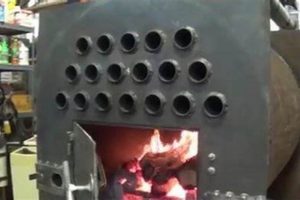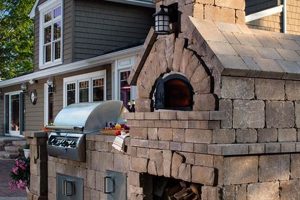Construction of a mechanized log-splitting device from individual components is a practice undertaken by individuals seeking customized solutions or cost-effective alternatives to commercially manufactured equipment. This approach involves sourcing materials such as hydraulic cylinders, pumps, valves, and steel, then fabricating a machine capable of exerting significant force to divide wood. For example, an individual might choose to build a unit tailored to handle unusually large or irregularly shaped logs found on their property.
The value lies in the potential for significant cost savings compared to purchasing a pre-assembled unit. Furthermore, it allows for customization to specific needs and preferences, leading to a more efficient and ergonomic tool for the intended application. Historically, such projects were necessitated by limited availability or high cost of commercial options, fostering ingenuity and resourcefulness in addressing a fundamental task.
The remainder of this document will delve into the practical aspects of conceptualization, design, fabrication, and safe operation of a user-assembled log splitter, covering aspects such as hydraulic system configuration, structural considerations, and appropriate safety measures.
Essential Considerations for Fabricating a Log-Splitting Apparatus
The construction of a user-built log splitter necessitates careful planning and execution to ensure safety and efficiency. The following guidelines outline critical aspects to consider during the fabrication process.
Tip 1: Hydraulic System Sizing: Accurate calculation of hydraulic pressure and flow requirements is paramount. Undersized components will result in diminished splitting force, while oversized components increase cost and may introduce instability. Consult hydraulic engineering resources for precise sizing calculations.
Tip 2: Structural Integrity: The frame must withstand substantial stress. Employ high-strength steel and proven welding techniques. Finite element analysis (FEA) can be used to simulate stress distribution and identify potential weak points prior to fabrication.
Tip 3: Wedge Design: The wedge geometry significantly impacts splitting efficiency. A sharper, more aggressive angle facilitates initial penetration, while a wider profile promotes complete separation. Consider the typical wood species to be processed when selecting or designing the wedge.
Tip 4: Cylinder Mounting: Secure and properly aligned cylinder mounting is crucial. Misalignment can induce stress on the cylinder and reduce its lifespan. Use precision measuring tools to ensure accurate alignment during installation.
Tip 5: Control Valve Placement: The control valve should be positioned for easy and safe operation. Ensure it is readily accessible but shielded from accidental activation. Consider incorporating a detent feature for hands-free operation during repetitive splitting tasks, but only if accompanied by appropriate safety measures.
Tip 6: Safety Features: Implement multiple safety features, including a two-handed operation system to keep hands clear of the splitting zone. A safety relief valve is essential to prevent over-pressurization of the hydraulic system.
Tip 7: Log Restraints: Incorporate restraints to prevent logs from rotating or ejecting during the splitting process. These restraints should be adjustable to accommodate different log sizes.
Adherence to these guidelines will significantly enhance the performance and safety of the fabricated log splitter, contributing to a more efficient and reliable wood processing operation.
The subsequent sections will address specific design considerations and best practices for each of these critical components, providing a comprehensive resource for those undertaking this construction project.
1. Hydraulic System Design
Hydraulic system design is a foundational element in the successful construction of a user-fabricated log splitter. It directly dictates the force available to split logs and the speed at which the splitting action occurs. An inadequately designed system will result in a machine unable to process logs efficiently, while an over-engineered system introduces unnecessary cost and complexity. For example, a system employing a pump with insufficient flow rate will produce slow splitting cycles, increasing the time required to process a given volume of wood. Conversely, a cylinder with too small a bore diameter will limit the maximum splitting force achievable, rendering the machine ineffective against larger or denser logs.
The hydraulic system comprises several interdependent components, including the pump, control valve, cylinder, and hydraulic fluid reservoir. Each component must be appropriately sized and matched to the others to achieve optimal performance. The pump’s flow rate, measured in gallons per minute (GPM), determines the speed of the cylinder’s extension and retraction. The cylinder’s bore diameter and operating pressure, measured in pounds per square inch (PSI), determine the splitting force. A relief valve is essential for preventing over-pressurization and potential damage to the system. Precise calculations, based on desired splitting force and cycle time, are crucial for selecting the appropriate components. Failure to properly account for pressure losses within the system can lead to significant discrepancies between theoretical performance and actual results.
In summary, the hydraulic system design is not merely a component of user-built log splitter; it is the core functional driver. A well-engineered system translates to an efficient, safe, and reliable machine. Conversely, deficiencies in design result in a machine that is either ineffective or presents a significant safety hazard. Thorough understanding of hydraulic principles and careful component selection are therefore paramount for any individual undertaking such a fabrication project. This understanding also highlights the importance of considering fluid dynamics when dealing with such machinery.
2. Structural Weld Integrity
The structural weld integrity of a user-built log splitter is paramount due to the immense forces involved in splitting wood. The welds act as the primary connection points between the various steel components, including the frame, cylinder mount, and wedge attachment. Deficient weld integrity leads to premature failure of these connections, potentially resulting in catastrophic equipment damage and significant safety hazards. For instance, a poorly executed weld on the cylinder mount could fracture under pressure, causing the cylinder to detach and become a projectile. Similarly, inadequate welds on the frame can lead to structural deformation, compromising the overall stability and functionality of the machine. The inherent risk is amplified by the cyclic loading experienced during repeated splitting operations, accelerating the fatigue process in compromised welds. The selection of appropriate welding techniques and filler materials, combined with meticulous execution, is therefore essential for ensuring the longevity and safety of the equipment. This must be considered when venturing into this kind of `wood splitter diy` scenario.
Proper weld preparation, including cleaning and beveling of the steel components, is crucial for achieving adequate penetration and fusion. The welding process should adhere to established industry standards, utilizing appropriate amperage, voltage, and travel speed to create strong, defect-free welds. Visual inspection of the welds is necessary to identify any surface imperfections, such as porosity, undercut, or incomplete fusion. Non-destructive testing (NDT) methods, such as dye penetrant inspection or ultrasonic testing, can be employed to detect subsurface flaws that may not be visible to the naked eye. Furthermore, the experience and skill of the welder significantly impact the quality of the welds. Hiring a certified welder or investing in proper training can mitigate the risk of weld failures. Examples of this include experienced welders using appropriate welding techniques to produce high quality welds to create a robust machine.
In conclusion, structural weld integrity is not merely a desirable attribute but a fundamental requirement for the safe and reliable operation of a user-constructed log splitter. Compromised welds represent a critical failure point, posing significant risks to both the equipment and the operator. Diligent attention to weld preparation, execution, and inspection is paramount, ensuring that the welds can withstand the demanding loads imposed during splitting operations. The risks of cutting corners could cause serious danger to the operator.
3. Component Sourcing Cost
The financial outlay associated with acquiring the necessary parts represents a significant determinant in the feasibility and practicality of constructing a log splitter independently. Strategic management of these costs is essential for achieving a financially viable project.
- Hydraulic System Acquisition
The hydraulic cylinder, pump, control valve, and associated hoses and fittings constitute a substantial portion of the overall expense. New components offer guaranteed performance and warranty coverage but typically carry a higher price tag. Alternatively, sourcing used or surplus hydraulic components presents a cost-saving opportunity, albeit with potential compromises in reliability and performance. Careful inspection of used parts is crucial to mitigate the risk of purchasing defective or worn-out equipment. For instance, a used hydraulic cylinder may exhibit internal leaks, reducing its splitting force and efficiency. This can directly affect the success rate of a `wood splitter diy` project.
- Steel Material Procurement
The steel frame and wedge require durable materials capable of withstanding significant stress. New steel offers consistent quality and known specifications but can be a considerable expense, especially for larger splitter designs. Scrap steel yards and metal recyclers may offer cost-effective alternatives, provided the material meets the structural requirements and is free from significant defects. The trade-off often involves additional labor for cleaning, cutting, and preparing the material for welding. The type of metal to use in `wood splitter diy` is important to consider for the best results.
- Engine or Motor Selection
The power source, whether a gasoline engine or an electric motor, represents a major investment. New engines and motors provide reliable performance and manufacturer warranties. Used engines and motors may offer cost savings but necessitate careful inspection for wear and potential mechanical issues. Factors such as horsepower, torque, and fuel efficiency should be considered to ensure adequate power for the intended splitting applications. Choosing the most efficient engine can improve the project and save on expenses in `wood splitter diy`.
- Hardware and Fasteners
The cost of bolts, nuts, washers, fittings, and other small hardware items can accumulate quickly. Purchasing these items in bulk often provides a cost advantage compared to buying them individually. The quality of the fasteners is critical for ensuring the structural integrity and safety of the machine. Low-grade fasteners may fail under stress, leading to equipment damage or personal injury. Sourcing these in a way that fits the budget for `wood splitter diy` can prove challenging.
Effective management of component sourcing costs requires a comprehensive understanding of material properties, hydraulic systems, and power requirements. Balancing cost savings with quality and safety is essential for successfully completing a user-built log splitter project within a reasonable budget. These challenges highlight the complexity of deciding to `wood splitter diy` instead of buying one.
4. Operator Safety Protocol
The establishment and rigorous adherence to comprehensive safety protocols are non-negotiable when operating a user-constructed log splitter. The inherent risks associated with high-pressure hydraulics, heavy machinery, and the potential for flying debris necessitate a stringent safety-conscious approach. The absence of formalized safety guidelines significantly elevates the risk of serious injury or even fatality. The success of any `wood splitter diy` project hinges not only on the machine’s functionality but also on the operator’s unwavering commitment to safe practices.
- Personal Protective Equipment (PPE)
Mandatory use of appropriate PPE is fundamental. Safety glasses or a face shield protect against ejected wood fragments and hydraulic fluid spray. Hearing protection mitigates the noise generated by the engine or motor. Heavy-duty work gloves provide hand protection from splinters and rough surfaces. Steel-toed boots prevent foot injuries from falling logs or machinery components. Failure to wear appropriate PPE significantly increases the risk of injury when operating the `wood splitter diy` machine.
- Operational Zone Clearance
Maintaining a clear operational zone is crucial. Bystanders, including children and pets, must be kept at a safe distance to prevent accidental injury from flying debris or moving parts. The work area should be free of obstructions, such as tools, loose wood, or uneven terrain, to minimize the risk of trips and falls. Regular inspection of the operational zone is essential to identify and address potential hazards. Considering the space used in `wood splitter diy` makes it safer.
- Two-Handed Operation Systems
Implementation of a two-handed operation system is a widely recognized safety measure. This design requires the operator to use both hands to engage the splitting mechanism, preventing the operator’s hands from being in the splitting zone during operation. The two-handed control system is especially important in `wood splitter diy` models. The absence of such a system significantly increases the risk of hand injuries. Regular inspection and maintenance of the control system are necessary to ensure its proper functioning.
- Hydraulic System Safety
Hydraulic systems operate under high pressure and pose significant risks. Before operating the splitter, all hydraulic connections should be inspected for leaks or damage. The hydraulic fluid level should be checked regularly and maintained at the proper level. The safety relief valve should be tested periodically to ensure it is functioning correctly and preventing over-pressurization. The DIY aspect of `wood splitter diy` means the pressure in the hydraulic system needs to be checked frequently.
These multifaceted safety protocols are vital components of the successful and safe operation of a user-built log splitter. Neglecting any aspect of safety significantly increases the risk of serious injury. Continuous vigilance and adherence to established safety guidelines are paramount when dealing with the inherent hazards associated with such machinery, particularly those built as `wood splitter diy` projects where adherence to rigorous safety standards may be more variable than professionally manufactured equipment.
5. Maintenance Schedule Regularity
The consistent implementation of a preventative maintenance schedule is critical to ensuring the longevity, safe operation, and optimal performance of any user-constructed log splitter. The unique challenges associated with “wood splitter diy” projects, stemming from potential variations in build quality and component selection, underscore the increased importance of vigilant maintenance practices. Neglecting scheduled maintenance routines can lead to premature component failure, reduced efficiency, and heightened safety risks. A regular maintenance schedule is a must-have for any `wood splitter diy` project.
- Hydraulic Fluid Analysis and Replacement
Regular analysis of hydraulic fluid samples provides valuable insights into the system’s health. Analysis can detect contaminants, such as water, metal particles, or air, which can degrade performance and accelerate wear. Scheduled fluid replacement, based on operating hours or fluid analysis results, maintains optimal lubrication and cooling, prolonging the lifespan of the hydraulic pump, cylinder, and valves. The correct fluid is also important in `wood splitter diy`.
- Hose and Fitting Inspection and Replacement
Hydraulic hoses and fittings are subjected to high pressure and physical stress. Regular inspection is necessary to identify signs of wear, cracking, or leaks. Damaged hoses or fittings should be replaced immediately to prevent catastrophic hydraulic failures and potential injuries. The maintenance schedule should include a pressure test to assess the integrity of the hydraulic system. Replacing these parts can be crucial to having a long-term `wood splitter diy` model.
- Engine/Motor Maintenance
For gasoline-powered splitters, scheduled engine maintenance is crucial. This includes regular oil changes, air filter cleaning or replacement, spark plug inspection, and carburetor adjustments. For electric motors, periodic inspection of wiring, connections, and bearings is necessary. Neglecting engine or motor maintenance reduces power output, increases fuel consumption, and potentially leads to complete engine/motor failure. It is also good to check on the quality of the engine for `wood splitter diy`.
- Structural Inspection and Weld Integrity Assessment
The structural integrity of the frame and welded joints should be inspected regularly for signs of cracking, bending, or corrosion. Any identified structural weaknesses should be addressed promptly through welding repairs or component replacement. A weakened frame poses a significant safety risk and can compromise the overall functionality of the splitter. This helps the frame support the structure in `wood splitter diy`.
By adhering to a well-defined and consistently executed maintenance schedule, owners of user-constructed log splitters can significantly enhance the reliability, safety, and operational lifespan of their equipment. This proactive approach not only minimizes the risk of unexpected breakdowns but also contributes to a safer and more efficient wood-splitting experience, reflecting the diligence and responsible ownership that are particularly important when engaging in a `wood splitter diy` undertaking.
Frequently Asked Questions
This section addresses common inquiries regarding the design, construction, and operation of independently built log-splitting apparatuses, offering clarification on key considerations and potential challenges.
Question 1: What is the minimum required splitting force for processing hardwoods?
The minimum force necessary to effectively split most hardwoods generally ranges from 20 to 25 tons. However, this value can vary depending on the specific wood species, diameter, and dryness. Denser hardwoods, such as oak or hickory, may require higher splitting forces. Underestimation of force requirements can result in inefficient operation and potential equipment strain.
Question 2: What are the key considerations for hydraulic cylinder selection?
Cylinder bore diameter, stroke length, and operating pressure rating are critical factors. The bore diameter dictates the splitting force, while the stroke length determines the maximum log length that can be processed. The pressure rating must exceed the maximum pressure generated by the hydraulic pump. Incorrect cylinder selection can lead to inadequate splitting force or premature cylinder failure.
Question 3: Is horizontal or vertical log splitter configuration inherently safer?
Neither configuration is inherently safer; safety depends primarily on operator adherence to established protocols and the implementation of appropriate safety features. Both horizontal and vertical splitters present unique hazards. Horizontal splitters can increase the risk of back strain from lifting logs, while vertical splitters require careful log positioning to prevent instability.
Question 4: What is the optimal wedge angle for efficient splitting?
The optimal wedge angle is a compromise between penetration and splitting force. A sharper angle facilitates initial penetration, while a wider angle promotes complete separation. Angles between 20 and 30 degrees are commonly used. However, the ideal angle can vary depending on the wood species and the overall design of the splitter.
Question 5: How frequently should hydraulic fluid be changed in a user-built log splitter?
Hydraulic fluid should be changed based on operating hours and fluid condition. A general guideline is to change the fluid every 500 hours of operation or annually, whichever comes first. However, more frequent changes may be necessary if the fluid becomes contaminated or discolored. Regular fluid analysis can help determine the optimal change interval.
Question 6: What are the potential legal liabilities associated with constructing and operating a homemade log splitter?
Individuals who construct and operate their own log splitters assume full responsibility for any resulting damages or injuries. There are no specific regulations governing the construction of such equipment. It is prudent to consult with legal counsel regarding potential liability issues and to ensure adequate insurance coverage. The absence of third-party certification necessitates meticulous attention to design, construction, and safety protocols.
In summary, the successful and safe construction and operation of a log splitter relies on a thorough understanding of engineering principles, adherence to established safety guidelines, and diligent maintenance practices. Addressing these frequently asked questions provides a foundation for informed decision-making.
The following section will delve into practical considerations for optimizing the performance and efficiency of a self-assembled wood processing device.
Conclusion
The preceding discussion has comprehensively examined various facets of constructing a mechanized log-splitting device from individual components. Key aspects explored included hydraulic system design, structural weld integrity, component sourcing cost considerations, operator safety protocols, and the implementation of regular maintenance schedules. The successful realization of such a project necessitates a robust understanding of engineering principles, a meticulous approach to fabrication, and an unwavering commitment to safety.
Engaging in “wood splitter diy” represents a significant undertaking, demanding careful planning and diligent execution. While the potential for cost savings and customization is evident, the inherent risks and complexities must be carefully weighed. Prospective constructors are urged to prioritize safety, adhere to established best practices, and continuously assess the potential liabilities associated with operating self-built machinery. Thorough preparation and a commitment to quality workmanship are paramount for achieving a reliable and safe log-splitting solution.







